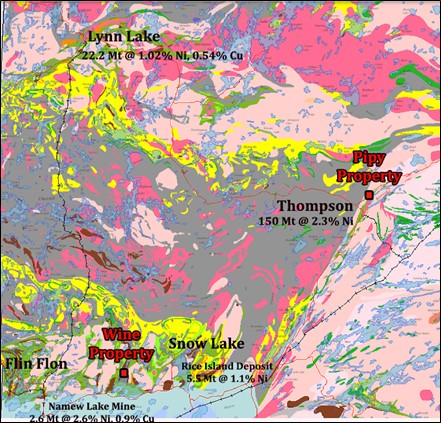Nickel in Manitoba
Manitoba has a long history of nickel mining and presently is the second largest nickel producing area in Canada along with by-products of copper, cobalt and platinum group elements.
Nickel mining in Manitoba has taken place since 1953 when Sherritt Gordon put the Lynn Lake deposit into production. They ultimately mined 22.2 million tonnes grading 1.02% Ni and 0.54% Cu until 1976 when operations closed down. The Lynn Lake mine is the fifth largest nickel producer in Canada after Sudbury, Thompson, Voisey’s Bay and Ragland.
In 1961 Inco commenced production at Thompson and the area has produced over 150 million tonnes grading 2.32% Ni and 0.16% Cu. Vale have recently announced that they have plans to continue nickel production at Thompson for at least another 10 years.
Location Map - Wine and Pipy Projects
NiCAN’s Wine Project is located north of the Namew Lake deposit, a past producer located in the Flin Flon area. The Namew Lake deposit was previously operated by Hudson Bay Mining and Smelting (now Hudbay Minerals Inc.) in partnership with Outokumpu Mining, commencing in 1988 and continuing for 5 years. Production was approximately 2.6 million tonnes grading 2.4% Ni and 0.9% Cu.
In the southeast of the province, the Dumbarton and Maskwa mines produced approximately 1.5 million tonnes grading 0.81% Ni from 1969 until 1976.
The Rice Island deposit in the Snow Lake area, located to the east of the Wine Project and held by Wolfden Resources, hosts a historic inferred resource, calculated by Inco, of 5.5 million tonnes grading 1.1 % Ni and 0.06% Cu. Exploration work is ongoing on this property.
At Thompson, the nickel mineralization is interpreted to be the result of ultramafic Molson Dykes intruding into Pipe Formation sulphide facies iron formation and sulphide bearing sedimentary rocks along the rifted Superior Province margin. The high degree of deformation and high metamorphic grade that characterizes the Superior Boundary Zone has resulted in the migration of nickel sulphide mineralization into low strain domains, such as fold hinges and fault zones, removing the mineralization from its original host. Much of this migrated mineralization incorporates country rock blocks giving it a breccia-like texture.
The Pipy Project is underlain by the Pipe Formation and is located 16 km north of Vale’s currently producing T1 and T3 mines. In the late 1960s Inco drilled at least 55 holes into what was known as the Mystery North zone, now NiCAN’s Pipy Project. There are no public historical drill assay results or diagrams of the configuration of the deposit.

